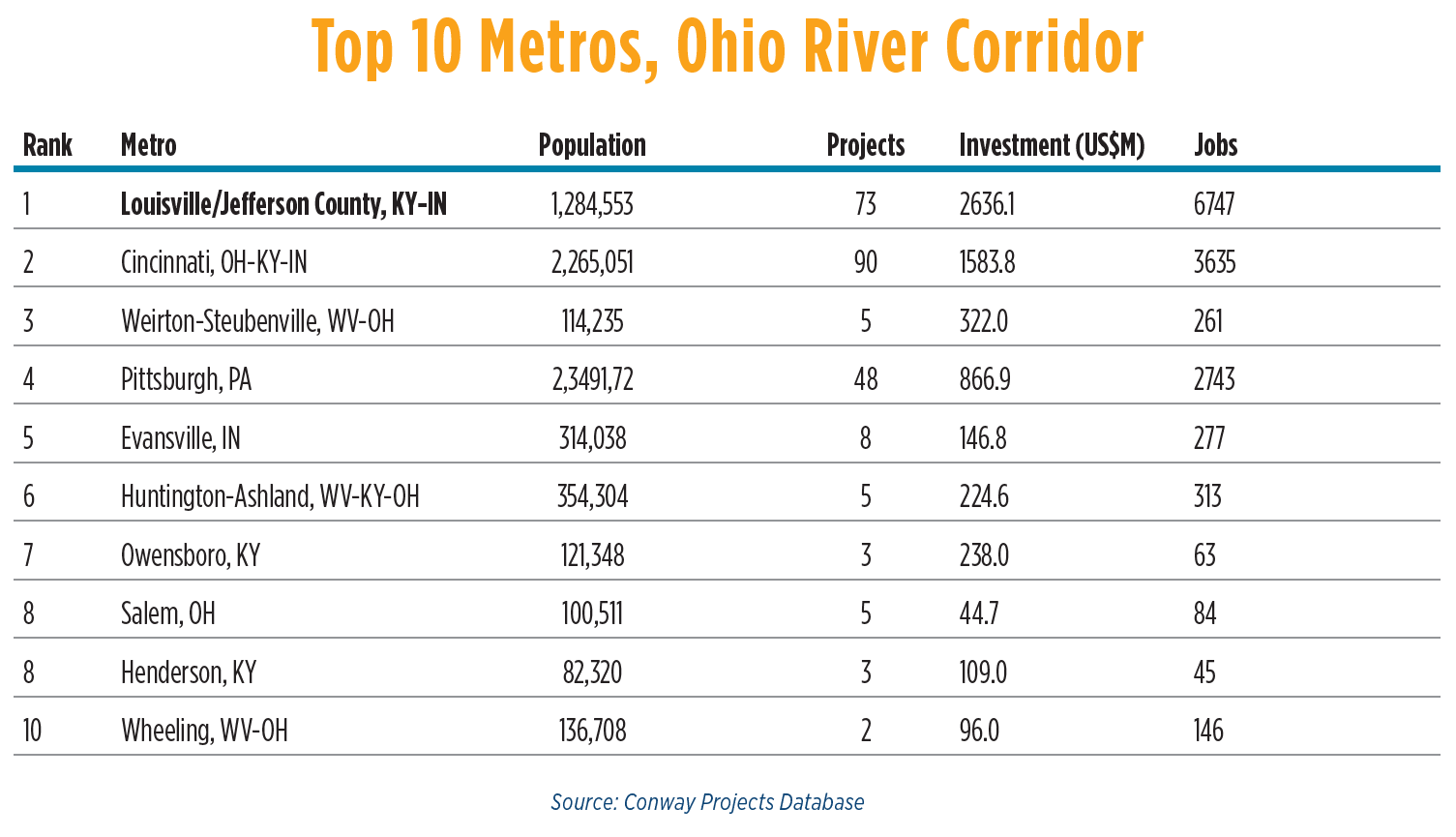Louisville and Cincinnati top this year’s rankings with major assists from communities across the river.
With a nod to regionalism that transcends alleged limitations like rivers, state lines and parochial thinking, Site Selection presents this year’s top metro areas along the entire length of the Ohio River corridor.
Louisville/Jefferson County repeats its No. 1 finish from last year, with the tri-state Cincinnati region regaining second place from this year’s No. 3 Weirton-Steubenville and Pittsburgh climbing back to No. 4 over this year’s No. 5 Evansville, Indiana.
Entering the top 10 after being absent last year are No. 7 Owensboro, Kentucky, and the two metros tied for No. 8: Salem, Ohio, and Henderson, Kentucky.
The rankings are based on points awarded across cumulative and per-capita categories derived from project tallies and project-affiliated capex and job creation numbers from March 2023 through mid-August 2024 in the Conway Projects Database.
Among the top 10, project tallies were down for the most part. However, the Louisville and Pittsburgh regions’ totals were slightly higher this year. Where Louisville really stands out are higher numbers in total capital investment (up by nearly $400 million) and job creation (a total of more than 6,740 jobs that is 2,400 higher than the previous time period’s total).
The bi-state region’s signature city leads the way when project data are viewed through a municipality lens. Forty projects in Louisville proper include headquarters and office investments by Congo Brands (500 jobs, $8.2 million invested) and civil engineering firm JQOL Global (113 jobs, $6.4 million), which has another Kentucky operation in the Ohio River city of Owensboro. Other projects in the city have come from such companies as Stellar Snacks (350 jobs, $137 million); Isopure; Raytheon; Amazon; Danish manufacturer Linak US and regional champion Papa John’s International, among others.

Electric linear actuator manufacturer Linak, which serves markets from health care to furniture to the marine and industrial sectors, is celebrating 30 years in Louisville, having grown from a literal garage to more than 360,000 sq. ft. across three buildings “with room to expand on the vast 39-acre campus,” the company said in June. “This growing infrastructure is a physical representation of thriving operations and future potential in the market.”
Notably, when project data are analyzed by county (including per-capita calculations), the No. 1 county along the entire river corridor is Clark County, Indiana, where 18 projects landed among a population of just over 31,000. The county that is part of metro Louisville saw most of its projects come to Jeffersonville, immediately across the bridge from Louisville. In fact, the county did not have to rely on per-capita calculations for its status: Its total investment amount of more than $2 billion in projects and total project-related job creation tally of nearly 3,150 jobs both outshone figures from all other counties touching the river.
Two of those projects are $800 million investments: one of them a Meta data center and the other a 1,200-job solar photovoltaic cell manufacturing operation from Canadian Solar announced in fall 2023. “This is the second of the anticipated long-term investments we expect to make in the U.S. as we think strategically about a local, sustainable and clean energy supply chain and to fulfill the long-term requirements of the local-content rules of the recently established IRA,” said Canadian Solar Senior Vice President Thomas Koerner, referring to the 10% production and investment tax credits in the federal Inflation Reduction Act.
Both the Meta and Canadian Solar projects are rising at the 6,000-acre River Ridge Commerce Center, which in 2023 was able to claim a nearly $3 billion impact on the Indiana economy. Enterprises at the redeveloped military base employed more than 18,500 people, with around 3,000 more jobs expected to come to the development in the next few years. The latest operation to land there comes from an organization that can keep up with those sorts of numbers: The U.S. Census Bureau’s National Processing Center will consolidate at a new single site from its former multiple-building campus after 60 years in the region. The General Services Administration signed a long-term agreement with Broe Group that will keep the center’s 600 jobs for another 20 years at the new facility.
Sundancinnati?
Cincinnati may be runner-up to Louisville in this year’s Site Selection rankings, but the Queen City beat out its rival to the southwest in another contest: In September, the Utah-based Sundance Institute announced Cincinnati, Ohio, as one of three finalists to host the Sundance Film Festival beginning in 2027. Louisville had competed in the previous round. The other two finalists are the Institute’s home base of Park City/Salt Lake City and Boulder, Colorado. The Institute says it will announce its selection of the host city after the 2025 Festival has concluded.
In a statement, Cincinnati Mayor Aftab Pureval and Film Cincinnati President and CEO Kristen Schlotman said, “As long-time attendees, we believe Cincinnati’s dedication to the arts, hospitality and historic theaters make it a great fit. We are inspired by the idea of partnering with the Sundance Institute to celebrate the festival’s rich legacy while introducing a dynamic, walkable and accessible new venue.”
Among films to be shot in the Cincinnati area in recent months are two projects from Sylvester Stallone, “Alarum” and “The Epiphany,” both of which received tax credits from the State of Ohio. The Ohio and Kentucky motion picture tax credits provide a refundable tax credit that equals 30% off on eligible productions.

